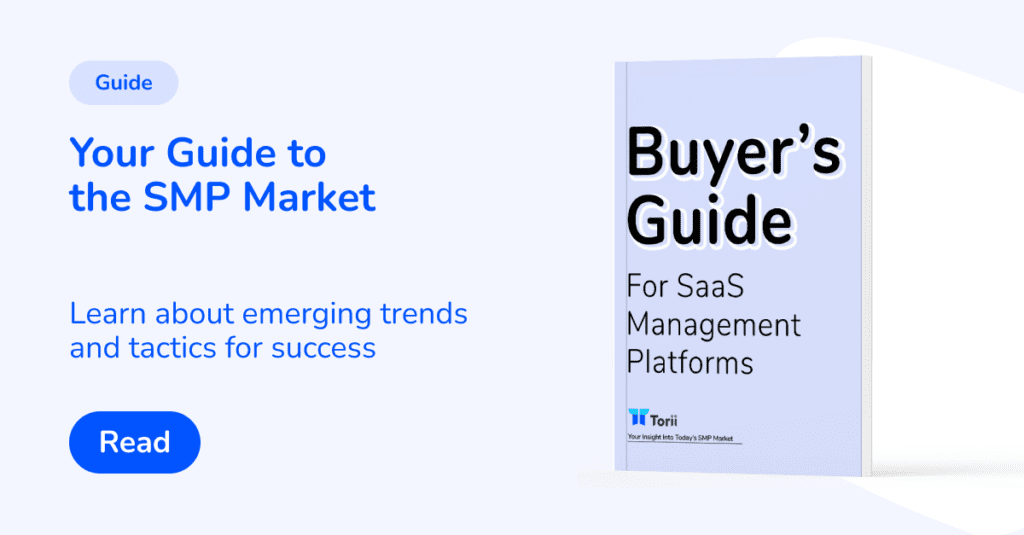What is it, why does it matter, and what’s next?
💡Key Points:
- SaaS Management is the act of discovering, managing, and taking critical actions on all your applications (both Shadow IT and sanctioned apps)
- SaaS Management is necessary due to the distributed nature of SaaS adoption
- IT professionals should consider a SaaS Management Platform (SMP) to help them better understand and manage their SaaS portfolio
- Ready to learn more? Download the Buyer’s Guide for SaaS Management Platforms.
What is SaaS Management? SaaS Management is all about getting insight into your messy app ecosystem and taking action based on that insight. SaaS Management is most often used for improving the employee and application lifecycles through automation, monitoring and improving SaaS spending, discovering newly added Shadow IT apps, monitoring the usage rates across multiple similar apps, and much more.
In this article, we’ll talk more about the utility of a SaaS Management Platform(SMP) as well as give some context on how we got here and where the industry is heading in the future.
- How Did We Get Here? (The SaaS Explosion)
- Distributed SaaS Adoption: The Good and the Bad
- Why We Need SaaS Management
- What Does SaaS Management Do?
- Three Critical Components for the Future of SaaS Management
- Conclusion: What Should You Do Now?
Note 💡 We just released the 2023 SaaS Management Platform Buyer’s Guide, full of industry insights, a Decision Matrix Template, and tips on what to look for in a SaaS Management Platform.
Before we can address those points, let’s take a step back and address how we got to this point.
How Did We Get Here? The SaaS Explosion
Before cloud applications, IT and Procurement would be gatekeepers for the software that entered our companies. As a result, new tools were implemented methodically, and most workers rarely participated in decision-making. Fast forward to today, and everyone with a web browser and a company email address can try, buy, and integrate cloud apps.
This is the SaaS Explosion—a tidal wave of new software bombarding our security, budgets, and efficiency.

This explosion in adoption has left old-fashioned processes and IT management strategies in shambles. But the explosion of SaaS didn’t just impact how many apps we have; it also affected where the data for those apps reside.
Distributed SaaS Adoption: The Good and the Bad
Today, app adoption is messy. Different users will take the initiative, try new apps, and implement them into the SaaS ecosystem.
This is good because it increases innovation and allows employees to find the best tools for their work. But, it also results in distributed application ownership and scattered app data.
Cost, contract, user, usage… all forms of data are scattered without a single place to get a complete picture, like puzzle pieces scattered throughout a house. Different teams might have part of the picture, but nobody has the whole story.
And this leads us to the need for SaaS Management.
Why Do We Need SaaS Management?
Managing SaaS is virtually impossible without an updated strategy and the right equipment. This is where a SaaS Management Platform comes into play.
An SMP fills the gaps left by antiquated IT Management strategies by improving our ability to:
- Discover Shadow IT
- Automate critical tasks like app deprovisioning during offboarding
- Identify wasted SaaS Spend
- Create an SSOT for app data
But for any SaaS Management initiative to be successful, it requires the strategic expertise of the IT team.
What Does SaaS Management Do?
SaaS Management is an evolving category that is constantly changing. However, there are still a handful of things that SaaS Management must do to be effective.
- Discover app usage for both sanctioned and unsanctioned applications within your organization
- Centralize that data and provide actionable next steps
- Automate the processes that are difficult or mundane
However, those basic necessities barely scratch the surface of what IT teams need to be successful. Let’s go into detail about what those capabilities are for the next phase of SaaS Management.
Three Critical Components for the Future of SaaS Management
Open Platform
While modern SaaS Management tools call themselves platforms (SMPs), few of them truly are.
Here’s an excerpt from our SMP Buyer’s Guide.
“As the SaaS management industry matures, it’s not just about what these platforms can do today; it’s about what they’ll be able to do tomorrow. Sure, different focuses like Spend Management or Security are important, but let’s zoom out for a moment. The real issue at hand is the architecture of these platforms. Are they open systems that allow for growth and adaptability, or are they closed systems that box you in?
Closed systems often lack API access or frameworks for building custom integrations and apps. They’re like a pre-furnished apartment—what you see is what you get. While they may excel in their specific focus areas, their lack of flexibility can be a significant drawback as your organization evolves. Imagine your needs suddenly change, your security requirements shift, or you try to adopt a new SaaS tool that doesn’t cooperate with your current SMP. With a closed system, you’re stuck trying to fit a square peg into a round hole.
On the flip side, platforms that offer resources for customizing your experience allow you to adapt and grow. They allow you to build custom integrations or even develop bespoke apps tailored to your unique needs. This adaptability can be a game-changer, especially for IT managers who need to think long-term and consider the ever-changing tech landscape.
So, as you evaluate different SaaS Management Platforms, consider whether you want an app to solve a specific problem today or a platform that offers potential for future adaptability.”

Ultimately, the future of SaaS Management will require platforms that enable adaptation, which means collaboration between customers and vendors toward a shared vision of SaaS Management.
Note 💡 See how Torii is embracing an open platform with our developer community, plugin marketplace, and API first approach to SaaS Management. Learn more.
Next-Generation Automation
In a recent Data Report, The State of IT Automation, we surveyed 200 IT pros and found out exactly what they thought about SaaS automation. Here are some of the top findings:
- Consistency over Speed: IT professionals value consistency (48%) more than speed (21%) in automation.
- Automation Adoption is Lagging: Less than half of respondents have fully automated most tasks, and only 13% reported great success with automation.
- Barriers to Automation Remain High: 64% of IT professionals cite a lack of tool education, and 58% cite insufficient staffing or time as major challenges in automation implementation.
- Ease of Use is Paramount: Over half (54%) of IT professionals prioritize ease of use when evaluating new automation software.
Essentially, SaaS automation is not consistently achieving expectations. This is why excellent automation is critical for SaaS Management.
SaaS Management should serve as the fulcrum of your entire SaaS operations. Basically, it becomes the enabler or the bottleneck for all of your automation.
For SaaS Management to evolve, it will require seamless, intuitive, mature workflow capabilities similar to what more mature industries have long enjoyed (think marketing automation or integration platforms).
Note 💡 Check out the latest Automation Updates to the Torii Platform, including a Canvas UI, infinite branching, and more.
Artificial Intelligence Capabilities
Two things are true. Artificial Intelligence is a buzzword, and AI is absolutely here to stay. The trick is finding the instances where AI adds true value.
SaaS Management is one of those instances, especially when it comes to pulling, matching, and managing SaaS data.
In fact, at Torii, we’ve been using AI from the start. We’ve long used AI in our Advanced Data Engine to discover, map, and match app and user data. And now, today’s generative AI is opening doors even more. Instead of pulling raw data, the large language models allow SMPs to extract data from semantic contexts, such as SaaS contracts and website text.
But where the most exciting advances are occurring is how AI allows individuals to access data via simple text-based requests.
Note 💡 Torii just released a new AI assistant that lets you ask any question about your SaaS Stack via a slack bot. So now your SaaS answers are just a slash command away. Learn more.
Conclusion: What Should You Do Now?
SaaS Management is a blossoming category of tools designed to help us reckon with the changes from the SaaS Explosion. But, each SaaS Management tool is a bit different. As top analysts at Gartner state in their Market Guide:
SaaS management platform (SMP) market fragmentation increases the risk that I&O leaders will buy a tool that does not address all of their requirements.
Ready to learn more? You’re in luck! We just released our SaaS Management Platform Buyer’s Guide.

